Showing all 7 results
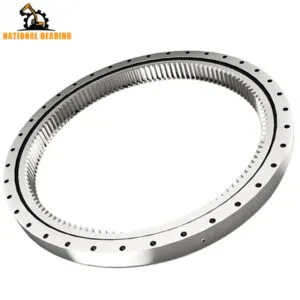
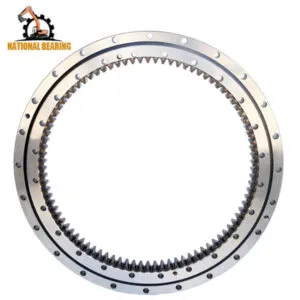
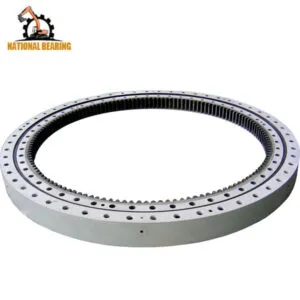
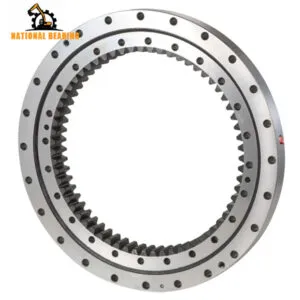


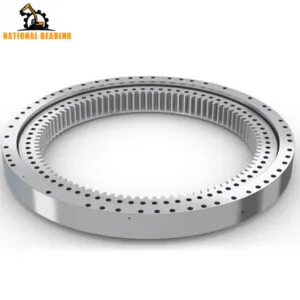
Maintaining your Hitachi excavator properly is crucial for extending the lifespan of its parts, including critical components like the swing bearing. Conduct regular inspections to identify wear and tear early. Check hydraulic hoses, filters, tracks, and the swing bearing for leaks, cracks, or abnormal wear. Early detection can prevent costly repairs and downtime.
Proper lubrication is vital for the smooth operation of moving parts. Ensure that all pivot points, joints, and bearings, including the swing bearing, are adequately greased according to the manufacturer’s recommendations. Correct lubrication reduces friction and prevents premature wear, extending the life of your excavator parts.
The hydraulic system is the heart of your excavator. Regularly check and replace hydraulic filters and fluid to prevent contamination, which can damage hydraulic components like cylinders and pumps. Also, inspect the tracks and undercarriage for proper tension and cleanliness. Clean the undercarriage to remove debris that can cause accelerated wear and corrosion.
Operator training is essential for minimizing wear and tear on excavator parts. Ensure operators are familiar with the machine’s controls and avoid overloading the excavator. Maintain detailed records of all maintenance activities, including inspections, lubrication, and part replacements. This helps track maintenance schedules and plan future tasks, ensuring your Hitachi excavator remains in excellent working condition.
Maintaining the hydraulic system of an excavator is crucial to ensure its efficient and reliable operation. One of the key aspects of this maintenance is the regular changing of hydraulic oil. The hydraulic oil plays a vital role in the smooth functioning of various excavator parts, including the hydraulic pump, hydraulic motor, cylinders, and other hydraulic components. Here’s a comprehensive guide on how often the hydraulic oil should be changed in an excavator:
The frequency of changing hydraulic oil in an excavator largely depends on the manufacturer's recommendations, the operating conditions, and the type of hydraulic oil used. Generally, most manufacturers, including Komatsu, Caterpillar, and Hitachi, recommend changing the hydraulic oil every 2,000 to 4,000 operating hours. However, it’s essential to consult the excavator's manual for the specific guidelines related to your machine model.
Operating conditions play a significant role in determining how often the hydraulic oil should be changed. Excavators working in harsh environments, such as construction sites with a lot of dust, dirt, and debris, may require more frequent oil changes. Contaminants can enter the hydraulic system and degrade the oil faster, leading to potential damage to the hydraulic pump, hydraulic motor, and other critical excavator parts. In such conditions, it might be prudent to change the hydraulic oil every 1,000 to 2,000 hours to ensure optimal performance and longevity of the hydraulic system.
The type of hydraulic oil used is another factor to consider. High-quality, synthetic hydraulic oils tend to last longer and provide better protection against wear and tear compared to conventional oils. These oils may allow for extended intervals between changes, but it’s still crucial to follow the manufacturer’s recommendations and monitor the oil condition regularly.
Regular oil analysis can be a valuable practice to determine the right time for an oil change. By analyzing the hydraulic oil, you can detect the presence of contaminants, degradation of oil properties, and early signs of wear in the hydraulic pump, hydraulic motor, and other excavator parts. This proactive approach helps in making informed decisions about oil changes, ensuring the hydraulic system remains in excellent condition.
In addition to changing the hydraulic oil, it’s essential to replace the hydraulic filters at the same intervals. The filters play a crucial role in removing contaminants from the hydraulic fluid, protecting the hydraulic pump, hydraulic motor, and other components from damage. Neglecting filter changes can result in clogged filters, reduced system efficiency, and potential failures in the hydraulic system.
In summary, while the general recommendation for changing hydraulic oil in an excavator is every 2,000 to 4,000 operating hours, various factors such as operating conditions and oil type can influence this interval. Regular oil analysis and adherence to the manufacturer’s guidelines are key to maintaining the health of your excavator parts, including the hydraulic pump and hydraulic motor. By following these practices, you can ensure the efficient and reliable operation of your excavator’s hydraulic system, reducing downtime and extending the lifespan of the machine.
The swing bearing, also known as the slewing ring or turntable bearing, is a crucial component in an excavator, facilitating the smooth rotation of the machine's upper structure. This component plays a vital role in the overall functionality and efficiency of the excavator, seamlessly integrating with other essential excavator parts such as the hydraulic pump and hydraulic motor. Here’s a detailed explanation of the function of the swing bearing:
The primary function of the swing bearing is to support and enable the 360-degree rotation of the excavator’s upper structure, which includes the cab, boom, and attachment. This rotation capability is essential for the excavator’s operation, allowing the operator to maneuver the boom and attachment to different locations without repositioning the entire machine. This functionality is particularly useful in confined spaces and complex work environments.
The swing bearing works in conjunction with the hydraulic system of the excavator. The hydraulic pump generates hydraulic pressure, which is then directed to the hydraulic motor responsible for driving the swing mechanism. When the operator activates the controls to rotate the upper structure, hydraulic fluid is directed through the hydraulic motor, converting hydraulic energy into mechanical motion. This motion is then transferred to the swing bearing, enabling the rotation.
The swing bearing is designed to handle significant axial, radial, and moment loads. It distributes the weight of the upper structure and the working loads generated during excavation tasks evenly across its surface. This distribution is crucial for maintaining the stability and balance of the excavator, preventing undue stress on other excavator parts such as the hydraulic pump, hydraulic motor, and undercarriage.
The design of the swing bearing ensures smooth and precise movement of the excavator’s upper structure. It typically consists of an inner ring, an outer ring, and rolling elements such as balls or rollers. These components work together to reduce friction and facilitate easy movement. The precision in the swing bearing’s design is essential for the operator to perform delicate and accurate maneuvers, especially in tasks requiring fine control.
Given the critical role of the swing bearing, its durability and maintenance are paramount. The swing bearing is subjected to continuous loads and environmental factors such as dirt, water, and debris. Regular maintenance, including proper lubrication and timely inspections, is necessary to ensure its longevity and reliable performance. Neglecting maintenance can lead to wear and tear, resulting in costly repairs and potential downtime.
The hydraulic pump is one of the most essential excavator parts, serving as the heart of the machine's hydraulic system. Its primary role is to convert mechanical energy from the engine into hydraulic energy, which is then used to power various functions of the excavator. Without a properly functioning hydraulic pump, the excavator would lose its ability to perform many of its crucial tasks.
The hydraulic pump works by drawing hydraulic fluid from the reservoir and pressurizing it. This pressurized fluid is then directed through a network of hoses and valves to different excavator parts such as the boom, stick, bucket, and other attachments. The pressurized hydraulic fluid is what enables these components to move smoothly and with significant force, allowing the excavator to dig, lift, and maneuver heavy loads efficiently.
One of the key roles of the hydraulic pump is to ensure that the hydraulic fluid is delivered at the right pressure and flow rate. This is critical for maintaining the performance and precision of the excavator's movements. For instance, when the operator moves the joystick to extend the boom or rotate the cab, the hydraulic pump adjusts the pressure and flow of the hydraulic fluid to execute these commands accurately and seamlessly. This precise control is vital for tasks that require exact positioning and smooth operation.
Another important function of the hydraulic pump is to distribute hydraulic power to multiple actuators simultaneously. In an excavator, multiple functions often need to be performed at the same time, such as lifting the boom while rotating the cab and extending the stick. The hydraulic pump ensures that each of these actions receives the necessary hydraulic power without compromising the performance of any single function. This ability to multitask enhances the efficiency and productivity of the excavator.
The hydraulic pump also plays a crucial role in the overall durability and longevity of the excavator. By maintaining the correct pressure and flow of hydraulic fluid, it minimizes the wear and tear on other excavator parts. Properly pressurized hydraulic fluid ensures that the seals, cylinders, and valves operate within their designed parameters, reducing the likelihood of leaks and mechanical failures. Regular maintenance of the hydraulic pump, including checking for wear and ensuring clean hydraulic fluid, can significantly extend the life of the excavator.
In summary, the hydraulic pump is a vital component among the various excavator parts, responsible for converting mechanical energy into hydraulic energy, delivering pressurized fluid to actuators, ensuring precise control, and distributing power efficiently. By maintaining the correct pressure and flow, the hydraulic pump enables the excavator to perform multiple functions simultaneously and with precision. Proper maintenance of the hydraulic pump is essential for preserving the performance and longevity of the excavator, making it a cornerstone of the machine’s operational efficiency.
The interchangeability of excavator parts between different models is a complex topic and largely depends on several factors such as the manufacturer, model specifications, and the nature of the parts themselves. While some excavator parts may be interchangeable, others may not be due to differences in design, size, and functionality.
Firstly, parts such as hydraulic cylinders, hoses, filters, and fittings often have more universal designs and can sometimes be used across different models and even brands. These components are designed to adhere to industry standards, making them more likely to be compatible with various machines. For example, hydraulic hoses and fittings are often built to standardized sizes and pressure ratings, which can facilitate their use in different excavator models.
However, more specialized excavator parts, such as the boom, stick, cab, and undercarriage components, are typically designed with specific models in mind. These parts are engineered to match the exact specifications, dimensions, and performance requirements of a particular model, making direct interchangeability less likely. For instance, the boom of one excavator model may have a different length, weight, or attachment mechanism compared to another model, rendering it incompatible.
Moreover, advancements in technology and design can further complicate the interchangeability of excavator parts. Newer models may incorporate cutting-edge materials, improved ergonomics, and advanced control systems that are not present in older models. As a result, parts from an older excavator may not meet the performance standards or fit the design constraints of a newer model, and vice versa.
The manufacturer’s guidelines and part numbers are crucial when determining the interchangeability of excavator parts. Manufacturers typically provide detailed parts catalogs and compatibility charts that specify which parts are suitable for which models. Adhering to these guidelines is essential to ensure proper fit, function, and safety. Using incompatible parts can lead to mechanical failures, reduced efficiency, and even safety hazards.
In some cases, aftermarket parts and third-party suppliers offer solutions that claim compatibility with multiple models. While these can be cost-effective alternatives, it’s essential to verify their quality and compatibility with your specific excavator model. Consulting with a qualified technician or the equipment manufacturer can provide valuable insights and help avoid potential issues.
In summary, the interchangeability of excavator parts between different models is not a one-size-fits-all answer. While some standardized parts like hydraulic components may be interchangeable, more specialized parts designed for specific models generally are not. Adhering to manufacturer guidelines and consulting with experts is crucial to ensure compatibility and maintain the performance and safety of the excavator. Properly matching the right parts to the right model can help extend the life of the machine and keep it operating at peak efficiency.
The most commonly replaced Komatsu excavator parts include hydraulic hoses, filters, tracks, teeth and adaptors, seals and gaskets, and undercarriage components. These parts require frequent replacement due to the demanding nature of excavator work, which involves constant movement, high pressure, heavy loads, and exposure to harsh conditions.
Hydraulic hoses are subject to high pressure and constant movement, leading to wear, cracks, and leaks. Filters, including hydraulic, fuel, and air filters, clog over time with dirt and debris, reducing their effectiveness and necessitating regular replacement to keep systems clean. Tracks experience significant wear from friction and impact, affecting the machine's stability and traction. Teeth and adaptors are directly involved in digging and material handling, exposed to stress and abrasive materials, causing them to wear down quickly.
Seals and gaskets deteriorate due to heat, pressure, and chemicals, leading to leaks and reduced hydraulic pressure. Undercarriage components, such as rollers, idlers, sprockets, and track chains, are in constant contact with the ground and bear heavy loads, resulting in significant wear. Regular maintenance and timely replacement of these parts are essential to keep the excavator running efficiently, minimize downtime, and extend the machine's lifespan. Proper care ensures that the Komatsu excavator remains reliable and performs at its best.
Finding the correct part number for specific Komatsu excavator parts is crucial for ensuring that your machine operates smoothly and efficiently. Here are some detailed steps to help you locate the right part number:
1. Consult the Operator's Manual: The operator’s manual that comes with your Komatsu excavator is an excellent starting point. This manual usually includes a parts catalog section with detailed diagrams and part numbers for various components. By referring to this section, you can identify the exact part number you need for replacement.
2. Use Komatsu's Online Parts Catalog: Komatsu offers an online parts catalog, which is a comprehensive and user-friendly resource for identifying part numbers. You can access this catalog through Komatsu's official website. The online catalog allows you to search by model number, part name, or part category. By entering the relevant information, you can quickly locate the part number you need.
3. Contact a Komatsu Dealer: If you are unable to find the part number through the manual or online catalog, contacting an authorized Komatsu dealer is a reliable option. Dealers have access to detailed parts databases and can assist you in identifying the correct part number. Provide them with your excavator’s model and serial number to ensure accuracy. Many dealers also offer online chat support or customer service hotlines for added convenience.
4. Check the Part Itself: Sometimes, the part you need to replace may have a part number stamped or printed on it. Inspect the old part carefully for any identifying numbers or labels. This information can be invaluable in ensuring you order the correct replacement part.
5. Use Equipment Management Software: If your company uses equipment management software, such as Komatsu’s KOMTRAX, you can leverage this tool to track and manage parts. These systems often include detailed parts information and can help you identify part numbers based on your equipment’s maintenance history and usage data.
6. Join Online Forums and Communities: There are many online forums and communities where Komatsu excavator owners and operators share information and advice. Participating in these communities can provide valuable insights and help you identify part numbers. Experienced members can often provide guidance based on their own experiences with similar issues.
7. Refer to Maintenance and Service Records: If you have kept detailed maintenance and service records for your excavator, these documents can be a valuable resource. Previous service records may include part numbers for components that were replaced in the past, helping you identify the correct parts for current needs.
In summary, finding the correct part number for specific Komatsu excavator parts involves consulting the operator’s manual, using Komatsu’s online parts catalog, contacting authorized dealers, inspecting the old part, utilizing equipment management software, participating in online forums, and referring to maintenance records. By following these steps, you can ensure that you obtain the right parts for your Komatsu excavator, minimizing downtime and maintaining optimal performance. Proper identification and sourcing of parts are essential for the longevity and efficiency of your equipment.
Firstly, generic parts such as hoses, filters, and seals can sometimes be compatible across different brands, including Komatsu. These parts are often standardized and can fit various models from different manufacturers. For instance, hydraulic hoses and filters used in Komatsu excavators might be interchangeable with those from Hitachi, Caterpillar, or Volvo, provided they match in specifications like size, pressure rating, and thread type.
Buckets and attachments are another category where some level of compatibility exists. Many excavator manufacturers, including Komatsu, produce buckets and attachments that can be fitted to machines from different brands, as long as the coupling mechanism is compatible. Adapters and quick couplers can further enhance this interoperability, allowing operators to use a Komatsu bucket on a Caterpillar excavator, for example.
When it comes to more specialized components like the swing bearing, compatibility becomes more restricted. The swing bearing, or slewing ring, is a critical part that supports the upper structure's rotation. These bearings are highly specific to the design and engineering of each excavator model. While there might be some overlap in dimensions and load capacities among different brands, it is generally not advisable to interchange swing bearings without thorough verification. Using a Komatsu swing bearing on a different brand's excavator without proper compatibility checks can lead to misalignment, excessive wear, and even catastrophic failure.
Electrical components such as sensors and control modules also tend to be brand-specific due to differences in electronic systems and software. While some sensors might have similar functionality, their connectors, calibrations, and communication protocols often differ, making direct compatibility rare.
Regular maintenance and timely replacement of excavator parts are essential to ensure the optimal performance and longevity of your Komatsu excavator. Critical components such as the swing bearing and swing reducer play a pivotal role in the machine's operation. Recognizing the signs that these parts need replacing can prevent costly downtime and potential damage to other components, such as the hydraulic pump. Here’s what to look out for:
Regular maintenance and inspection of your Komatsu excavator parts, including the swing bearing and swing reducer, are crucial. Ensuring that these components are adequately lubricated and free from contamination can significantly extend their service life. Additionally, addressing any signs of wear or damage early can prevent further issues and potential failures in other critical parts, such as the hydraulic pump.
Recognizing the signs that indicate it’s time to replace specific Komatsu excavator parts like the swing bearing or swing reducer is essential for maintaining the efficiency and reliability of your machine. Look out for excessive play, unusual noises, visible wear, uneven rotation, loss of swing power, hydraulic fluid leaks, increased temperature, and unusual vibrations. By addressing these signs promptly and performing regular maintenance, you can ensure the longevity and optimal performance of your Komatsu excavator and its hydraulic pump.